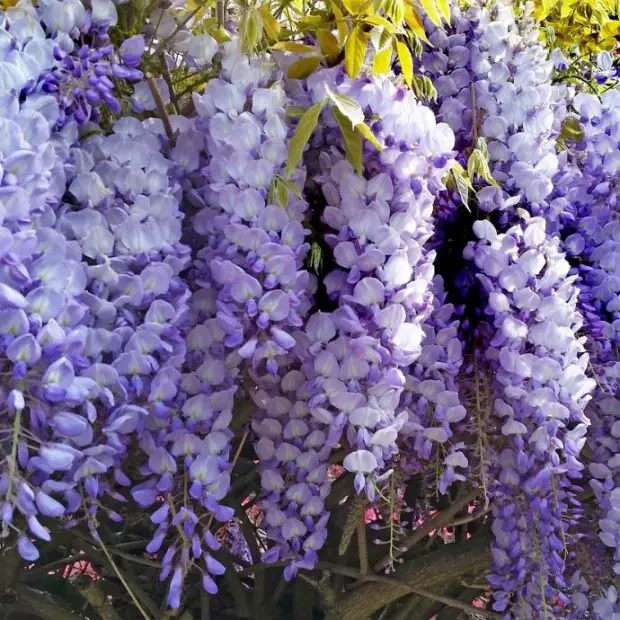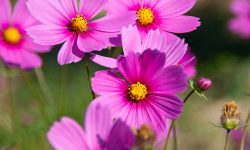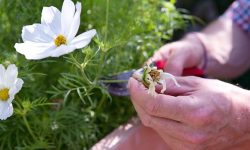There’s something truly enchanting about walking beneath a canopy of blooming wisteria. The way its lavender or white blossoms cascade like waterfalls, releasing a soft, sweet fragrance into the air, feels like stepping into a fairytale. Wisteria doesn’t just decorate your garden—it transforms it, creating a peaceful escape filled with elegance, charm, and natural beauty.
Growing wisteria is more than gardening; it’s an experience that rewards patience with breathtaking results. With the right variety, care, and a bit of guidance, you can train this vigorous vine to drape gracefully over pergolas, fences, and trellises, turning even the simplest spaces into a garden retreat you’ll never want to leave.
Choosing the Right Wisteria Variety for Your Garden

Selecting the right type of wisteria is the first step to growing a beautiful, manageable vine that fits your garden’s style and climate. In the U.S., the most popular choices are Chinese wisteria (Wisteria sinensis), Japanese wisteria (Wisteria floribunda), and American wisteria (Wisteria frutescens).
Chinese wisteria is known for its rapid growth and bold, fragrant blooms, but it can be invasive in some regions. Japanese wisteria offers longer flower clusters and elegant appearance, making it a favorite for dramatic displays. For gardeners who prefer a native, less aggressive option, American wisteria is ideal—it’s better behaved, blooms slightly later, and is more suitable for smaller spaces.
When choosing your variety, consider your USDA zone, available space, and how much maintenance you’re willing to do. Matching the right species to your garden ensures healthier growth, fewer issues, and a more rewarding display year after year.
Finding the Best Spot to Plant Wisteria
Choosing the right location is essential for wisteria to grow vigorously and bloom abundantly. Wisteria loves sunlight and performs best when planted in full sun, receiving at least 6–8 hours of direct sunlight per day. While it can survive in partial shade, flowering will be significantly reduced without adequate light.
The soil should be well-draining and moderately fertile, ideally with a slightly acidic to neutral pH (around 6.0 to 7.0). Avoid planting in compacted or waterlogged areas, as wisteria roots do not tolerate excess moisture and can easily rot. Raised beds or sloped areas with good drainage are ideal.
Because wisteria is a strong, woody vine, it needs to be planted next to a solid support structure. Choose a location near a pergola, arbor, fence, or custom-built trellis that can withstand the plant’s weight and long-term growth. Avoid placing it near your home’s siding, gutters, or delicate wooden structures, as mature wisteria can damage weaker materials.
Also, give your plant plenty of space to spread—wisteria can grow 10 to 30 feet or more in every direction. Planting it in an open area ensures it won’t overwhelm nearby plants or become tangled in other garden features.
A well-chosen site will provide the perfect conditions for your wisteria to flourish, bringing years of cascading blooms and timeless charm to your garden.
How to Plant Wisteria for Long-Term Success
Planting wisteria correctly from the start sets the foundation for years of vigorous growth and stunning blooms. Begin by selecting a healthy nursery-grown plant—ideally one that is already grafted or propagated from a flowering specimen, as seed-grown wisteria can take many years to bloom.
Dig a hole that is twice as wide and just as deep as the root ball. Loosen the surrounding soil and mix in compost or well-rotted manure to improve fertility and drainage. Gently place the plant in the hole, keeping the top of the root ball level with the soil surface. Fill in with soil, firm gently, and water thoroughly to eliminate air pockets.
Space plants at least 10–15 feet apart if you are planting more than one. Install a strong support system, such as a pergola or heavy-duty trellis, at the time of planting. This allows the plant to climb and develop properly without needing major adjustments later.
Water regularly during the first growing season to help the roots establish. Apply a layer of mulch to retain moisture and suppress weeds, but keep it a few inches away from the base of the stem.
With proper planting and early care, your wisteria will anchor itself strongly and reward you with cascading blossoms and graceful foliage for decades to come.
Watering and Feeding Your Wisteria
Wisteria thrives in well-draining, fertile soil that supports strong root development and abundant blooms. Start by loosening the soil to a depth of at least 12 to 18 inches, breaking up clumps and removing rocks or debris. This encourages deep root penetration and healthy growth.
Mix in organic matter such as compost, aged manure, or leaf mold to enrich the soil and improve its structure. This boosts moisture retention without causing sogginess—crucial for preventing root rot. Aim for a slightly acidic to neutral pH between 6.0 and 7.0, which provides the ideal nutrient balance for wisteria.
If your soil is heavy clay or poorly drained, amend it with sand or fine gravel and consider planting on a raised mound or in a slightly elevated bed to ensure proper drainage. Before planting, test the soil’s pH if possible and make adjustments with garden lime (to raise pH) or sulfur (to lower it) as needed.
Well-prepared soil gives your wisteria the best possible start, ensuring strong root establishment, vigorous vine growth, and stunning floral displays year after year.
Pruning for Shape, Size, and More Flowers
Pruning is essential for managing wisteria’s vigorous growth and encouraging abundant flowering. Without regular pruning, wisteria can become tangled, overly large, and slow to bloom. The right technique helps control its size, trains it into a beautiful form, and stimulates flower production.
Start by pruning wisteria twice a year: once in late winter or early spring (February or March) and again in mid to late summer (July or August). The winter prune focuses on shaping the structure—cut back long shoots to 2 or 3 buds to direct energy into flower buds rather than leafy growth. Summer pruning controls excess growth by shortening the long, whippy shoots from the current season down to about 6 inches. This encourages the plant to form short spurs, which are where flowers typically develop.
Train young wisteria onto a sturdy structure, like a pergola or arbor, and tie main stems loosely but securely. Remove any suckers or unwanted side shoots that grow from the base or lower trunk to keep the vine focused on upward and outward growth.
Regular, thoughtful pruning not only keeps your wisteria manageable but also transforms it into a lush, sculptural focal point in the garden, full of cascading blooms each spring.
Encouraging Your Wisteria to Bloom
Wisteria is beloved for its spectacular, cascading flowers—but getting it to bloom, especially in the first few years, can require patience and the right care. If your wisteria is growing vigorously but not flowering, a few key strategies can help coax it into bloom.
First, make sure your wisteria is mature enough—many varieties grown from seed can take 7 to 15 years to flower. To avoid long delays, always choose grafted or nursery-grown plants known to bloom within 3 to 5 years.
Next, avoid overfeeding with high-nitrogen fertilizers, which promote leafy growth at the expense of flowers. Instead, use a balanced or low-nitrogen fertilizer in spring to support bud development. You can also encourage blooming by stressing the plant slightly—this can be done by root pruning in late fall (digging a spade around the base 12–18 inches from the trunk to cut shallow roots) to redirect energy toward reproduction.
Sunlight is also essential. Ensure your wisteria receives at least 6 hours of direct sunlight daily. Plants in too much shade will struggle to form buds.
Lastly, consistent and correct pruning plays a major role. As mentioned earlier, pruning in summer and again in winter helps shift the plant’s focus from foliage to flower buds.
With time, proper training, and a little encouragement, your wisteria will reward you with breathtaking blooms that become more impressive each year.
Overwintering and Cold Protection
Wisteria is generally hardy, but young plants and certain varieties need protection in colder climates. Most Chinese and Japanese wisteria tolerate USDA zones 5 to 9, but late frosts can damage buds and prevent flowering.
To overwinter successfully, mulch the base of the plant in late fall with straw, shredded bark, or compost to insulate the roots. For container-grown wisteria, move pots to a sheltered spot like an unheated garage or against a warm wall. Water sparingly in winter—just enough to keep the roots from drying out.
In regions with harsh winters, wrap young vines in burlap or frost cloth to prevent cold injury. Avoid pruning in late fall, as cuts may stimulate tender new growth vulnerable to frost. With minimal care, your wisteria can survive winter and return strong and ready to bloom in spring.
Common Pests and Problems
Wisteria is relatively low-maintenance but can face a few pests and issues that hinder its health and blooming. The most common pests include aphids, scale insects, and Japanese beetles. Aphids cluster on new shoots, sucking sap and causing distortion. Spray them off with water or apply insecticidal soap. Scale insects appear as small bumps on stems and can be managed with horticultural oil.
Japanese beetles may chew on leaves and flowers in summer—handpick them early in the morning or use beetle traps placed away from the plant.
Wisteria may also suffer from bud blast, where flower buds dry and fall off before opening—usually caused by late frosts or poor drainage. Ensure the plant is in well-draining soil and protected from cold snaps when buds are forming.
Yellowing leaves can signal overwatering, poor soil drainage, or a nitrogen imbalance. Check the soil moisture and adjust feeding as needed. With regular monitoring and quick action, most problems can be easily controlled, allowing your wisteria to thrive.
il drainage, or a nitrogen imbalance. Check the soil moisture and adjust feeding as needed. With regular monitoring and quick action, most problems can be easily controlled, allowing your wisteria to thrive.
Propagating Wisteria at Home
Propagating wisteria at home is a rewarding way to grow new plants and share their beauty. The most common methods are softwood cuttings, layering, and seed propagation, though each has its pros and cons.
Softwood cuttings are taken in late spring to early summer from fresh, non-woody growth. Cut a 4–6 inch section with at least two leaf nodes, remove the lower leaves, dip it in rooting hormone, and plant it in a moist, well-draining mix. Keep it warm and humid—roots typically form in 4–8 weeks.
Layering is another reliable method. In early spring, bend a low-growing stem to the ground, make a small cut on the underside, and bury that section under soil while anchoring it with a stone or pin. Roots develop over several months, and the new plant can be separated from the parent in fall.
Growing wisteria from seed is possible but slow. Seeds can be planted indoors in winter but may take years to bloom—if ever. Also, seed-grown plants don’t always retain the traits of the parent plant.
For faster and more reliable blooms, vegetative propagation (cuttings or layering) is the best method to grow wisteria successfully at home.
Why Grow Wisteria in Your Garden?
Wisteria is more than just a flowering vine—it’s a transformative plant that brings timeless charm, vibrant color, and romantic elegance to any outdoor space. Its cascading clusters of fragrant blooms in shades of purple, blue, pink, or white can turn a simple garden into a breathtaking retreat each spring.
Beyond its beauty, wisteria is also highly versatile. It can be trained to climb pergolas, fences, arches, or even shaped into small trees, making it ideal for both formal and cottage-style gardens. The dense foliage provides natural shade, privacy, and structure, while its twisting vines add architectural interest year-round.
Wisteria is also long-lived and low-maintenance once established. With proper pruning and care, it will continue to reward you with spectacular blooms for decades. Growing wisteria not only enhances your garden’s visual appeal but also invites pollinators like bees and butterflies, supporting a healthy ecosystem.
For gardeners seeking a stunning centerpiece with lasting impact, wisteria is a timeless and rewarding choice.
FAQ About Grow Wisteria
What is the best time of year to plant wisteria?
The ideal time to plant wisteria is in early spring or fall, when temperatures are mild and the plant can establish roots before facing extreme heat or cold. Spring planting gives it the entire growing season to settle, while fall planting allows roots to develop in cool, moist soil before dormancy.
How long does it take for wisteria to bloom?
Wisteria can take 3 to 5 years to bloom when grown from a young plant or cutting, and up to 10 years from seed. To encourage earlier flowering, choose a grafted or nursery-grown plant, and ensure it’s getting plenty of sun, regular pruning, and not too much nitrogen fertilizer.
How much sun does wisteria need?
Wisteria requires at least 6 hours of direct sunlight each day to produce abundant blooms. Although it can tolerate partial shade, insufficient sunlight will lead to more leafy growth and fewer flowers.
Can wisteria damage buildings or fences?
Yes, wisteria’s strong, woody vines can become invasive if not properly managed. When grown on structures, it needs a strong support system, such as a metal arbor or reinforced pergola. Avoid planting it near wooden fences or house walls unless it’s regularly pruned and monitored to prevent damage.
How do I prune wisteria for better flowering?
Wisteria should be pruned twice a year: once in summer (July or August) to cut back new shoots to about 6 inches, and again in late winter (February) to shorten those shoots to 2–3 buds. This keeps the vine in shape and directs energy toward flower production instead of excessive foliage.
Conclusion
Wisteria is more than just a vine—it’s a statement of natural beauty and timeless elegance. With proper planting, care, and pruning, it can become the heart of your garden escape. Whether draped over an arbor or climbing a sunny wall, wisteria’s fragrant, flowing flowers offer a breathtaking display that rewards patience and attention with unmatched beauty for years to come.






